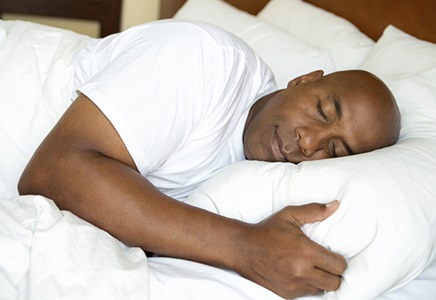Sleep Study
What is a sleep study?
The basic recordings done during a sleep study may include:
-
Electroencephalography (EEG) . This measures brain wave activity.
-
Electrooculogram (EOG). This measures eye movement.
-
Electromyography (EMG). This measures muscle movement.
-
Other recordings . An electrocardiogram (ECG) may be used to record electrical activity of the heart. Video recordings may also be made of you while you sleep.
Sleep studies generally take place in a sleep lab during your normal sleeping hours. The goal is to record brain and body activity that happens during sleep so that sleep disorders can be diagnosed and treated.
During a sleep study, the following may be measured:
-
Eye movement. The number of eye movements and their frequency or speed.
-
Brain activity. The electrical currents of the brain.
-
Limb movement. The number and intensity of movements.
-
Breathing patterns. The number and depth of respirations.
-
Heart rhythm. The electrical activity of the heart.
-
Oxygen saturation. The percentage of oxygen in the blood.
-
Acid/base balance of the stomach. The amount of acid secreted during sleep.
-
Sleep latency. The time it takes to fall asleep.
-
Sleep duration. The period of time a person stays asleep.
-
Sleep efficiency. The ratio of the total time asleep to the total time in bed.
In addition, these tests may be done:
-
Multiple sleep latency tests (MSLT) measure how long it takes to fall asleep
-
Multiple wake tests (MWT) measure whether you can stay awake during specified times.
Doctors trained in sleep medicine evaluate test results to treat sleep issues. A trained sleep technician will be with you in the sleep lab during the testing period.
Why might I need a sleep study?
Common reasons for a sleep study include:
-
Excessive snoring
-
Sleep apnea (periods where the breath stops)
-
Daytime sleepiness
-
Insomnia (inability to sleep)
-
Narcolepsy (sudden onset of sleep)
-
Restless legs syndrome (condition causing uncomfortable leg sensations)
Nightmares during nondream stages of sleep (sleep terrors), sleep walking or talking, and rapid eye movement disorders are less common conditions that may also require a sleep study.
There may be other reasons for your healthcare provider to recommend a sleep study.
Get a Better, More Restful Night’s Sleep

More than 60 million Americans suffer from poor sleep quality, and more than 40 million meet the diagnostic criteria for sleep disorders. Sleep is critical to a healthy mind and body – learn how to get a better, more restful night’s sleep in the Johns Hopkins Healthy Sleep portal.
What are the risks of a sleep study?
There are no known risks for a sleep study other than possible skin irritation due to the attachment of the electrodes to the skin.
How do I get ready for a sleep study?
-
Your healthcare provider will explain the procedure and you can ask questions.
-
You may be asked to limit your sleep before the study, avoiding naps for example.
-
Tell your healthcare provider of all medicines (prescription and over-the-counter) and herbal supplements that you are taking. They may alter test results.
-
Avoid caffeine-containing products for several days before the testing as they may cause you to take longer to fall asleep.
-
Unless directed by your healthcare provider, sedatives are usually not allowed during the sleep study as they can alter results.
-
A sleep questionnaire or diary may be given to you (and your bed partner, if applicable) to fill out ahead of time. Do your best to give true responses.
-
Showering before going to the sleep lab may be helpful. But, avoid using lotion or oil on your skin because the electrodes may not stick to the skin.
-
You may be urged to bring your own pajamas and pillow.
-
If needed, you may be able to shower and dress for work the morning after the sleep study.
-
Based on your condition, your healthcare provider may ask for other preparation.
What happens during a sleep study?
A sleep study is generally done on an outpatient basis at night. Procedures may vary based on your condition and your healthcare provider's practices.
Generally, a sleep study follows this process:
-
You will need to remove any jewelry or other objects that may interfere with the procedure.
-
You will change into pajamas or a hospital gown.
-
Small metal discs, or electrodes, will be positioned on your head and body for EEG, ECG, EOG, and EMG cables.
-
Pulse oximetry measures the oxygen level in the blood vessels through a small clip placed on your finger. Air flow monitors measure breathing.
-
The temperature of the room may need to be maintained at a certain level, but blankets can be adjusted as needed.
-
Lights will be turned off and monitoring will start before you fall asleep.
-
For multiple sleep latency testing (MSLT), short naps will be assigned at intervals.
-
For multiple wake testing (MWT), you will be asked to try and stay awake for certain periods.
-
When the study is complete, the electrodes and other devices will be removed.
What happens after a sleep study?
You won't need any special care after a sleep study. Results may take several days. However, your healthcare provider may give you other instructions after the procedure, based on your situation.

